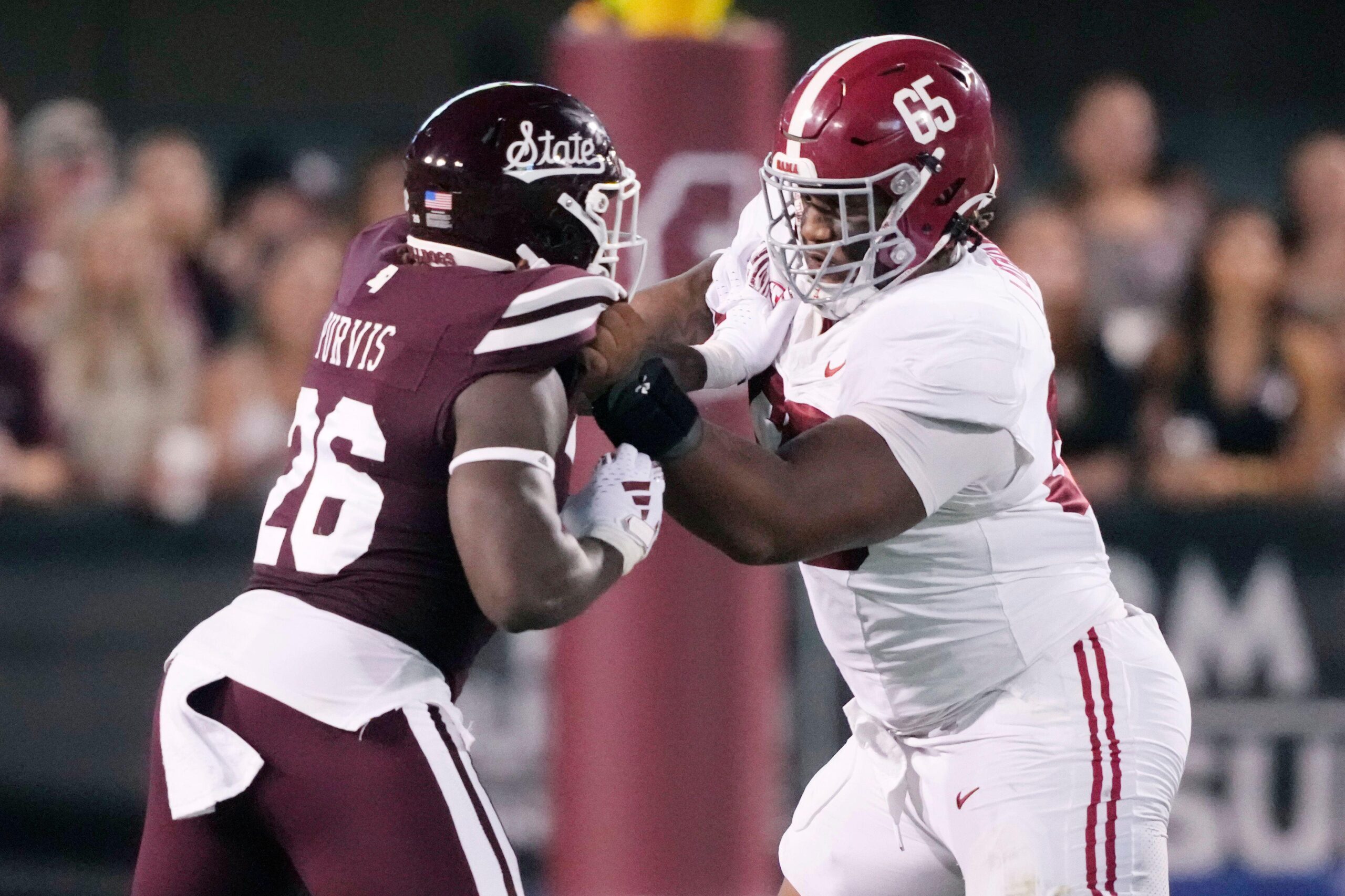I love analyzing Offensive Linemen through the lens of StatsBomb engagement data. No proxies, no guesswork, real-boy data. If this is your first foray into StatsBomb engagement data (first off welcome, it’s awesome), this is what we generate as part of our engagement collection:
- Who is involved in the block
- Field location of block starting point (x,y coordinates)
- Field location of block ending point (x,y coordinates)
- Field location of each player involved in the block (x,y coordinates)
- Time the block starts
- Time the block ends
StatsBomb is the ONLY PLACE to get this data. Not NGS, not PFF, or any other company. Only StatsBomb. As Uncle Ben tells a young Spiderman, “With great power, comes great responsibility.” My responsibility is to ensure this data is seen by the world and is utilized to improve the analysis of offensive lineman. I only wish I had some of Peter Parker's superpowers to go along with my responsibility.
Last year in prep for the NFL Draft I wrote an article on some of the offensive line metrics we had at that point in time. Since then, we have added quite a bit to our arsenal of analysis (patent pending).
Blocking Points
Let’s start with the beginning of what we are collecting in our event data listed above: who is involved in a block, and where the block starts. I have been a judge for the NFL Big Data Bowl presentations for the past few years and after spending time with our data I am always shocked at the amount of time and thought that goes into intuiting blocks. People make assumptions about blocking (and tackling, but that’s a different article) using some combination of player location, player orientation, and player speed/acceleration. With our data, someone can skip this step, and get right into the analysis
As a visual learner and someone who loves to make data look as close to things on a chalkboard as possible, let’s dive into using the blocks on an individual play first, and what that looks like.
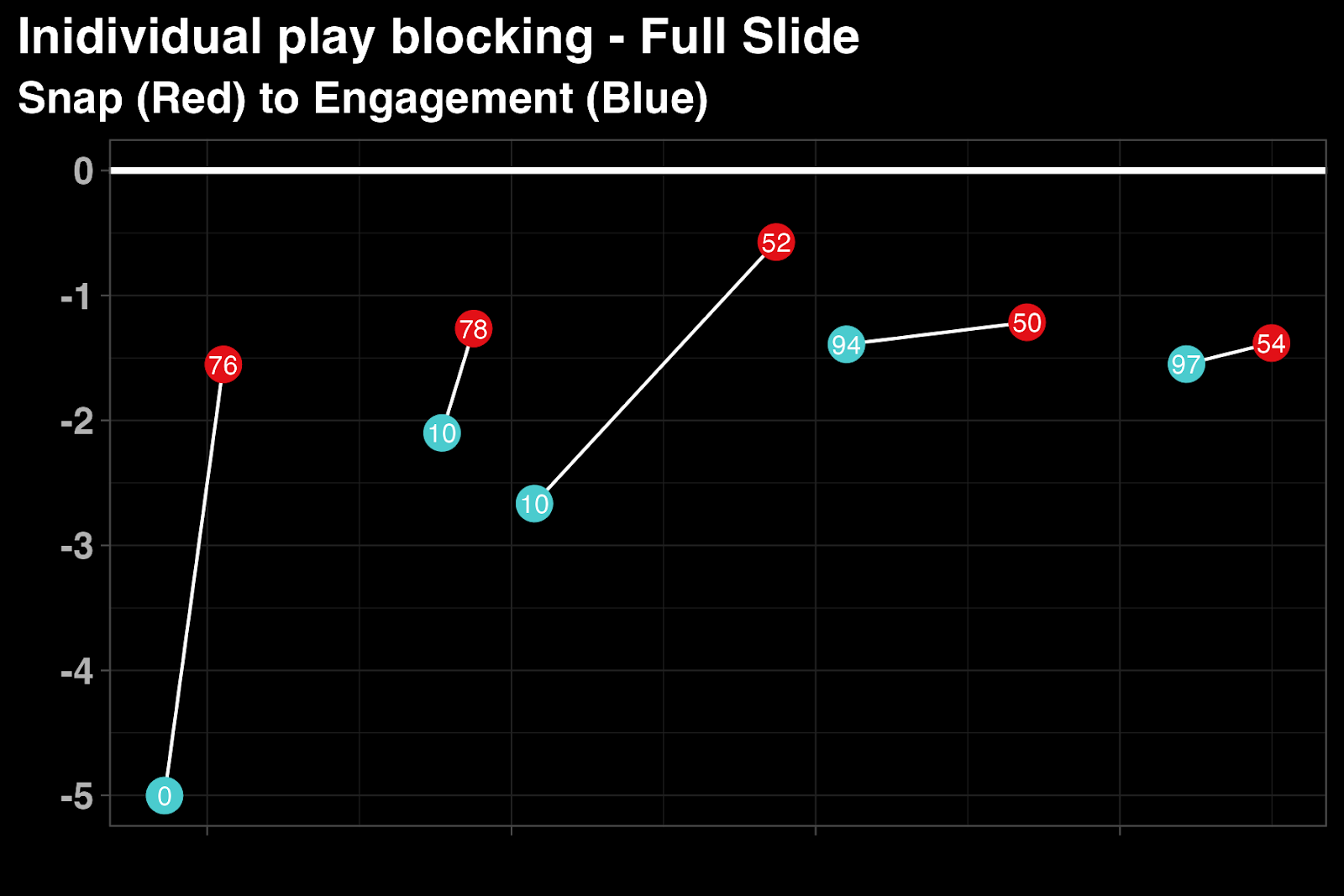
The play above shows an offensive line in a full slide to the left tackle. The Left Tackle (#76) blocks #0. The Left Guard and Center both slide left and end up double teaming #10. The Right Guard and Right Tackle hard slide and block #94 and #97 respectively.
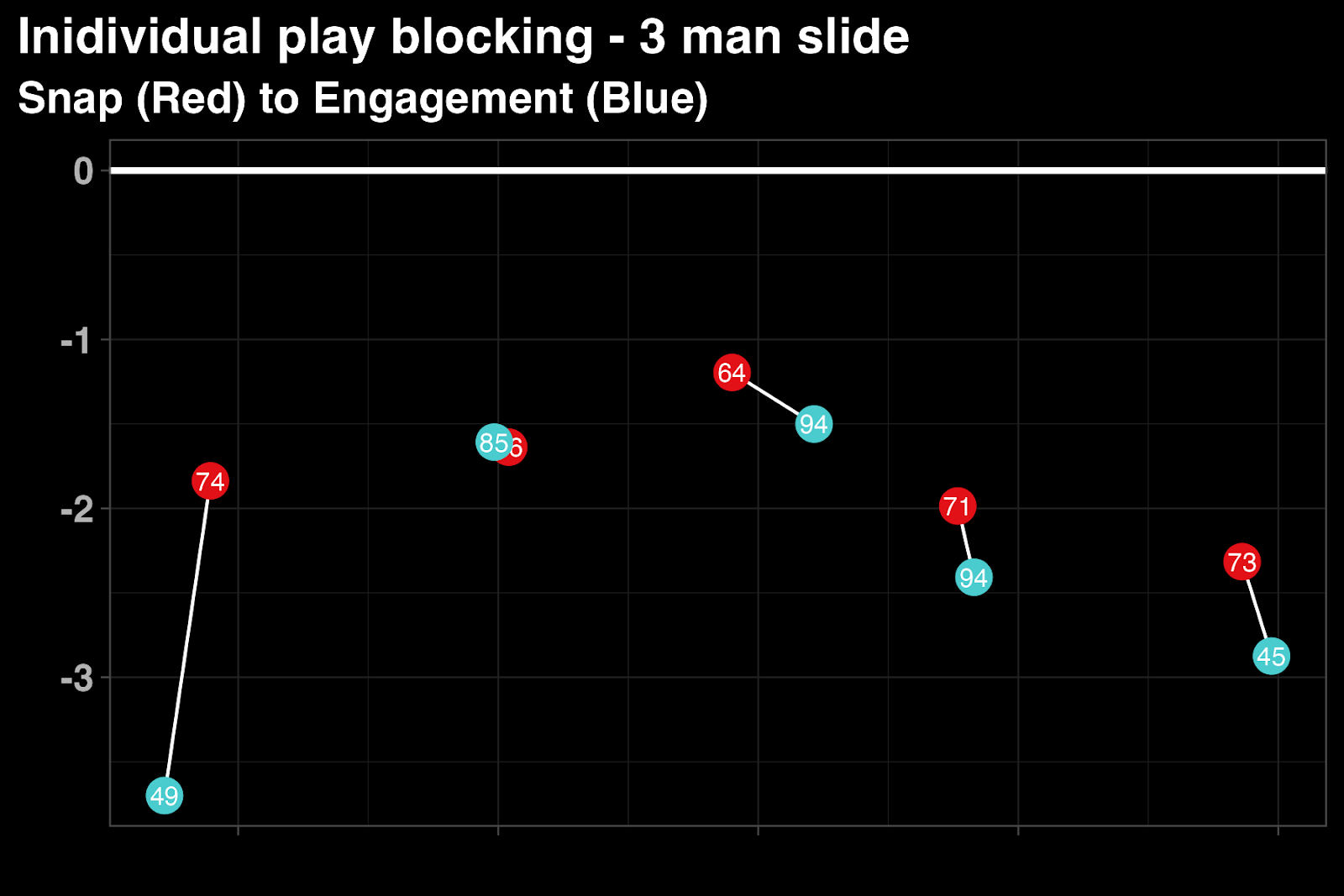
The next play is a 3 man slide with the Center sliding right and joining the Right Guard in blocking #94. The Left Guard quickly sets and blocks the defender right in his initial position. Another thing of note is the change in depth of blocking for the Left Tackle and Right Tackle. The Left Tackle kicks into a deeper set than the Right Tackle.
Another interesting application of the data is to analyze individual matchups. Last season, Taliese Fuaga and Laiatu Latu met up when Oregon State took on UCLA. These two potential first-round draft picks in the upcoming draft matched up in 6 true pass rush scenarios. Each of those matchups is in the visual below.
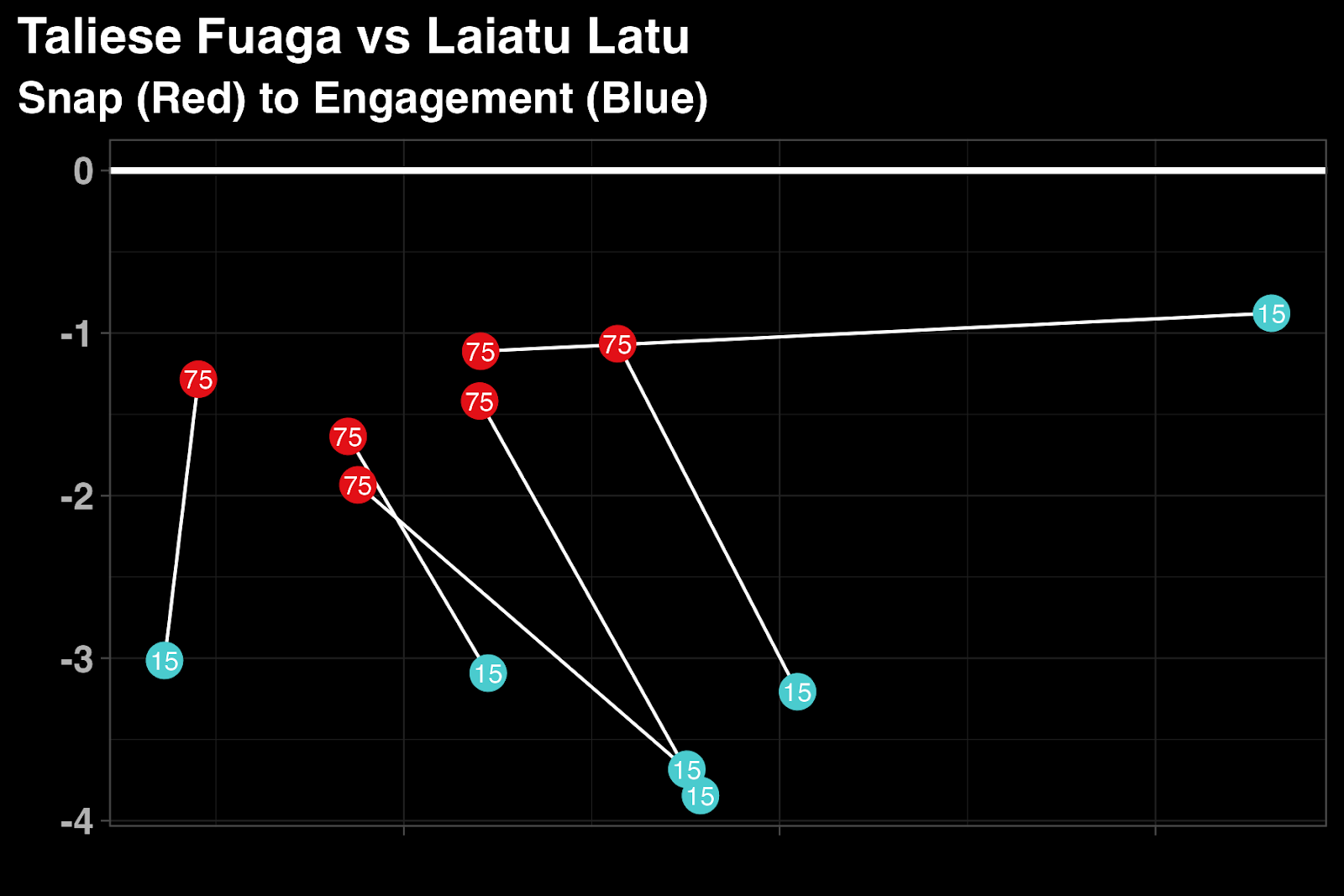
Using this data, OL and DL coaches (as well as the players) can be more efficient when analyzing individual matchups. Using information like individual matchups, block types, OL drop depths, pressure gaps, time to pressure, and ALOE (introduced below), creating cutups has never been so easy The time saved by this data is immeasurable for these groups that have never had this type of data and information before, allowing for deeper analysis in other areas.
Earlier this week, our own Data Scientist Abi Williams wrote an article about using the line engagements data in the run game. Using the location of the players at the snap, and the location of where the engagement starts and stops, we have classified 7 different run block types. It’s a great read, please check it out if you haven’t already.
Block Length
A great coach that I worked with in the past said that defensive football can be boiled down to two things: beating blocks and making tackles. For offensive lineman, the inverse of the first point is key. Offensive lineman want to stay on blocks for as long as possible. The next area of the data allows for analysis of this aspect of football. Using time stamps from the video and our synced event data, we are able to look at how long engagements last.
At StatsBomb we have created a new metric using our engagement data called Average Length of Engagement (ALOE). We split plays up by play type to get Run ALOE and a Pass ALOE.
Pass ALOE
On pass plays, we consider blocks ended when the QB throws the ball on plays where the QB throws the ball past the line of scrimmage, or when the ball carrier passes the line of scrimmage on a pass behind the line of scrimmage. When looking at Pass ALOE, we only consider plays where the ball is thrown past the line of scrimmage. This gives us a better look into actual pass sets. Below is a list of the top 10 Tackles from the 2023 NFL season in regards to their Pass ALOE.
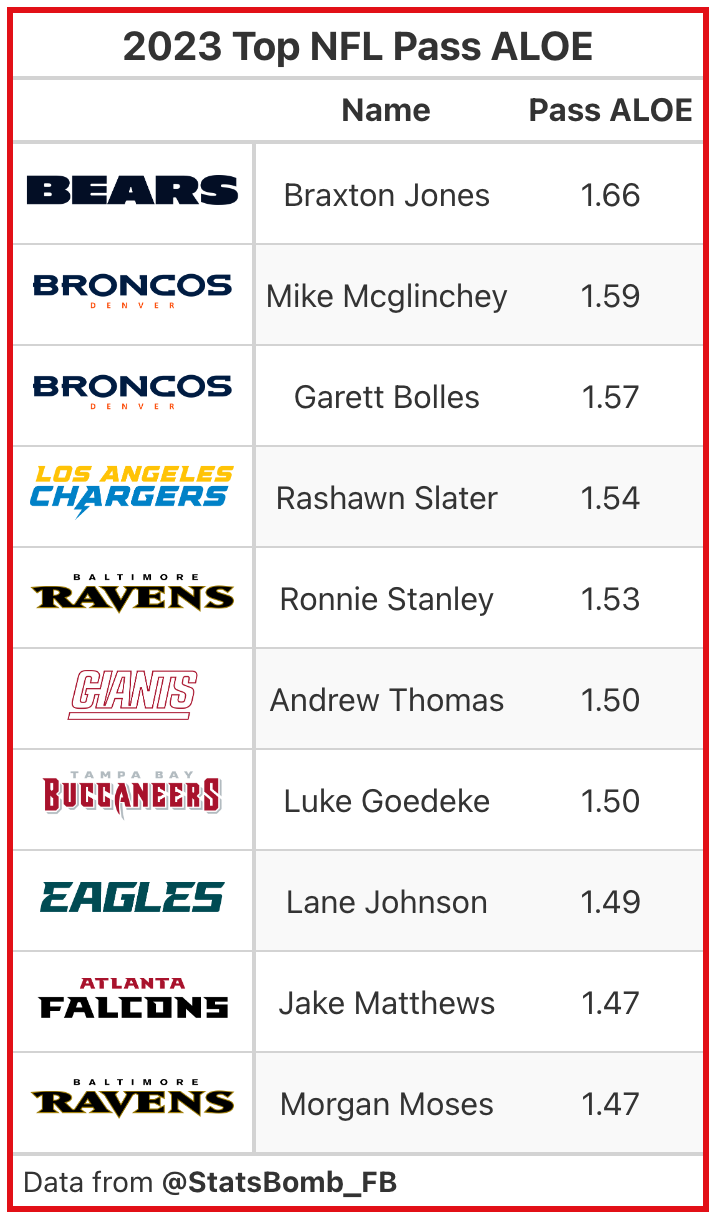
Taking a look at the data, it is not surprising to see Braxton Jones leading the league in Pass ALOE. Justin Fields was one of the most likely scrambling QB’s in the NFL last season. Mike Mcglinchey and Garett Bolles were part of an offensive line unit that blocked for Russell Wilson who had the 2nd highest time to throw in the NFL last season. Luke Goedeke is a surprising name as an unheralded 2nd year player that moved from Guard to Tackle before the season. Baker Mayfield had one of the quickest time to throw numbers last season, but Goedeke was able to sustain his blocks and be in the top 10 in pass ALOE.
Using these rules based on the timestamps, we can not only look at length of engagement, but if the OL stayed on his block until the QB released the ball. This can be utilized as a building block for pass block success and pass block win rate. If an OL is able to sustain a block until the pass is thrown, and the defender doesn’t get close, or impact the QB in any way, that is a great place to start in deeper OL analysis.
Run ALOE
Let’s move to the FBS level for a deeper dive into the run game. Below is a chart with the top 10 Tackles in terms of Run ALOE. Things of note for the top 10 are both starting Tackles for Wisconsin landing in the top 6. Phil Longo and his run-first scheme found success in utilizing Nelson and Mahlman’s run blocking skill. #1 rated Tackle Victor Stoffel returns to college football next year after he was gobbled up by Cal in the transfer portal. While many of the top 10 return to school for another season, Delmar Glaze rounds out the top 10 as a NFL Combine invite and future potential draft pick.
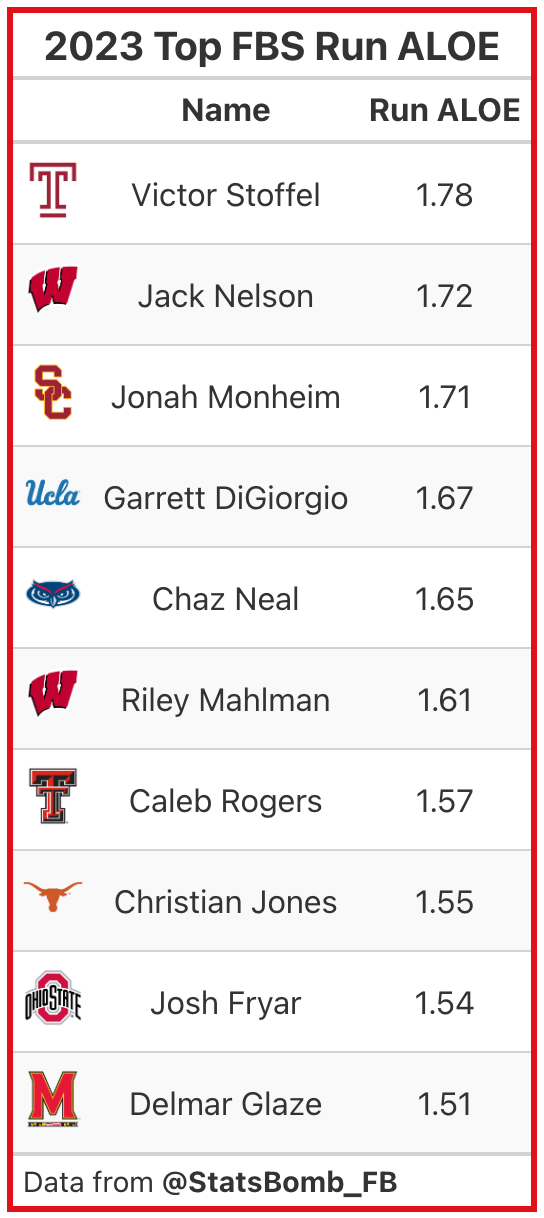
Top 2024 Tackle Prospects
This is an incredibly deep draft for Offensive Tackles. We may even match the record of 7 taken in the first round in 2008 (Daniel Jeremiah had 8 in his 1.0 projections, but has since gone down to 7). With such a strong group of talent, using metrics like ALOE can help show differences in their playing styles.
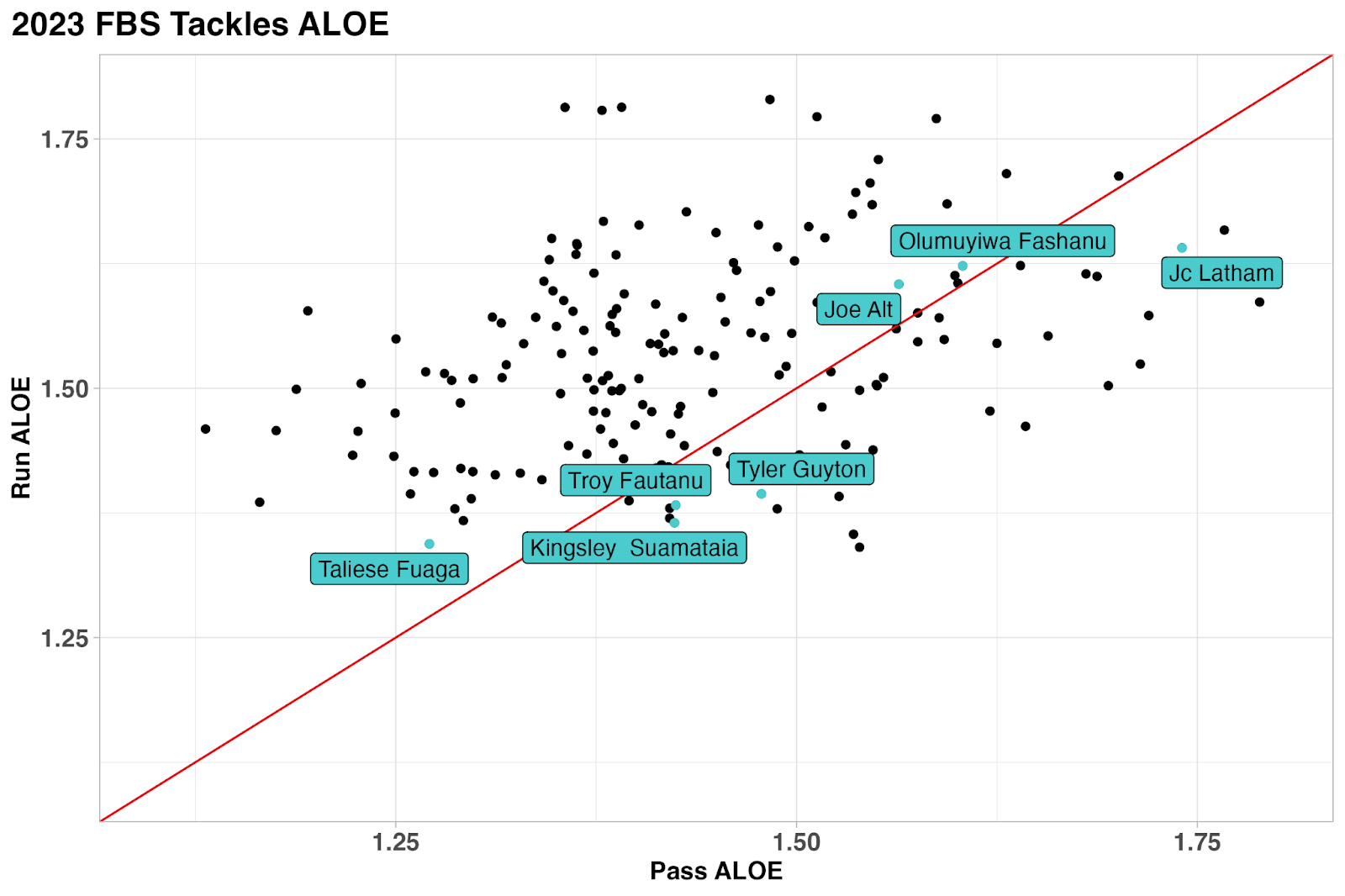
First, a few broad thoughts on the plot above. The majority of players have higher Run ALOE than Pass ALOE as they fall above the red line. With the differences of what is asked of a Tackle in pass protection vs run blocking, this intuitively makes sense. Tackles retreat on the snap before engaging a defensive player, while moving forward in the run game to engage defensive players right away. Of note for all the highlighted players is that they are either close to the line or below it.
Joe Alt, Olu Fashanu, and JC Latham (most places consider these the top 3 of the 1st rounder crew, not to be confused with the 2 live crew) have the highest Pass and Rush ALOE’s of the bunch. While Taliese Fuaga is among the lowest of any Tackle in both Run and Pass ALOE. Using only ALOE, there are 3 tiers of Tackles for the Draft. The Joe Alt, Olu Fashanu, JC Latham tier. The Troy Fautanu, Tyler Guyton, Kinglsey Suamataia tier. And then Taliese Fuaga in a group by himself.
Future Work & Conclusion
One of the next things on our roadmap for physical metrics (speed, acceleration, etc) is utilizing players weights, mixed with the engagement data to start producing things like player load. How much mass is one human moving? How does that change from the 1st Q to the 3rd Q. How quickly can one person move a 360 lb DL?
Offensive lineman have been underrepresented and underanalyzed from a statistical point of view for too long. It is my great responsibility to make sure that isn’t the case going forward.
Matthew Edwards
Head of American Football Analysis
@thecoachedwards

